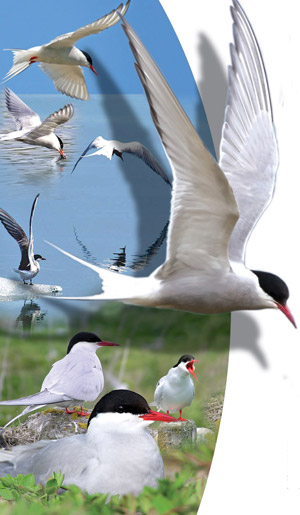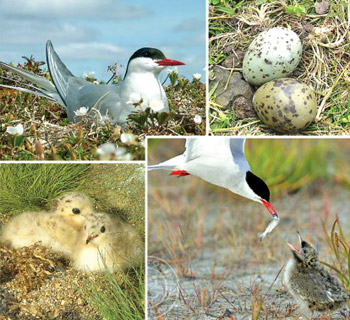Nature trail
Arctic Tern
Champion migrant
You may have heard of this small but mighty feathered friend that has
managed to grab the title of the long distance champion among its kind
due to its migratory habits
 The
Arctic Tern (Sterna paradisaea), though relatively small, with a lenght
of about 12 to 15 inches and weighing under two pounds is one of the
most determined birds in the world. It has not let its size be an
obstacle to accomplishing the remarkable feat of migrating over 22,000
miles (35,000 km) each year. The
Arctic Tern (Sterna paradisaea), though relatively small, with a lenght
of about 12 to 15 inches and weighing under two pounds is one of the
most determined birds in the world. It has not let its size be an
obstacle to accomplishing the remarkable feat of migrating over 22,000
miles (35,000 km) each year.

Would you believe that the distance that it migrates is the longest
of any bird?. More than the distance it flies, what is most remarkable
is the fact that the Arctic Tern almost never lands! As Arctic Terns
hardly ever land they eat while flying most of the time. When terns eat
insects they catch them "on the wing". This means they catch them while
flying. These birds see two summers each year as they migrate from their
northern breeding grounds along a winding route to the oceans around
Antarctica and back. It is a round trip of about 70,900 km (c. 44,300
miles) that they complete each year. This is by far the longest regular
migration by any known species of animal. The Arctic terns not only fly
but they also glide through the air performing almost all of their
routine tasks in the air. They come down to land once every one to three
years and that too depending on their reproduction cycle - the need to
nest. Once they complete the nesting period, they are off again taking
to the sky for yet another long southern migration.
These circumpolar animals are found in the entire northern hemisphere
- Arctic area. They are mainly grey and white plumaged, with a red beak
which is as long as the head, and very straight, and feet, white
forehead, a black nape and crown (streaked white), and white cheeks. The
grey mantle is 305 mm, and the scapulars (area near shoulder blades) are
fringed brown, some are tipped white. The upper wing is grey with a
white leading edge, and the collar is completely white, as is the rump.
The deeply forked tail is whitish, with grey outer webs. The hindcrown
to the ear-coverts is black. The distinguishing characteristics that
make these birds stand out among other birds are the black markings
under each wing and the bright orange beaks.
Arctic Terns are birds with a long lifespan, many reaching thirty
years of age. What do you think these birds live on, especially since
they are in the air most of the time? They live on mostly fish, shrimp,
krill, insects and small marine invertebrates. It is interesting to find
out how they manage to catch the fish since they are airborne all the
time. Research has shown that Arctic Terns are not very fond of being in
the water, in fact they will do everything possible to stay out of the
water.
The main reason for this is that terns are not good swimmers even
though their feet are webbed. They have rather small feet so they cannot
swim well. What they do is swoop down, once they spot a prey, catch the
fish, and then keep flying. Anything to stay out of the water!.Arctic
Terns are an abundant species, with an estimated one million individuals
found. The birds breed north of the 50th parallel. As we said earlier
this is the only time that these birds stop flying and come down to
earth... During the breeding or courtship time male terns fly a "fish
flight".

They take a small fish in their bill and pass as low as they can over
the female on the ground. If she notices him she'll join him in doing
this "fish flight" and they will soon mate.
The females lay clutches of one to three eggs in grassy areas for
protection from their predators and also because there are no trees in
the Arctic. Both the male and female terns help incubate the eggs. The
eggs hatch in about 23 days after they are laid.
The hatchlings leave the nest quickly and hide in nearby vegetation.
Until the little ones can fend for themselves the parents feed them.
They catch small fish and carry it in their bills to the hatchlings.
**********
Fact file
* Both the tern and the hummingbird can hover in midair. Most birds
are not able to do this. This is an important thing for the tern to be
able to do when it hunts or does its "fish flight".
* Arctic Terns are popular among fishermen because by monitoring
where the terns hunt they are able to find large schools of fish and
increase their catch. Fish normally swim in schools that include both
large and small fish and natives watch to see where Arctic Terns are
feeding to pinpoint where large schools of fish can be found.
* Arctic Terns which are medium-sized birds have a wingspan of
76cm-"85 cm (26-30 in).
* Even though they are in the gull family they don't have feet like a
gull's. They have webbed feet similar to those of ducks. They are not
only considered remarkable for their flying abilities, but also for
their social habits.
* They live together in groups of about 50 individuals which are
called colonies. Sometimes they adopt to their colony different species
of terns and also sea gulls.
*Arctic terns begin breeding around four years of age. The breeding
grounds of the Arctic Tern are along the Atlantic sea coast, mostly
between Greenland and New England, and some northern islands of the
Atlantic ocean. In the Pacific ocean, the Arctic terns breed at the
northern end of the Pacific and in the Bering Sea. In late August or
Early September, the birds and their young fly to Antarctica and the
nearby ice packed islands. They will fly back north again the next year,
arriving in the Arctic around June or early July.
* The birds fly a stable migration course, and only make deviations
to fly around large icebergs
* The Arctic Tern is closely related to and sometimes mistaken for
its two cousins, the Antarctic tern and Kerguelen tern.
* The Arctic Tern flies about 24,000 miles each year, from its
northern Arctic temperate breeding grounds to Antarctica and back,
seeing two summers each year.
**********
Its varied calls...
The species has a variety of calls; the two most common being the
alarm call, made when possible predators (such as humans or other
mammals) enter the colonies, and the advertising call. The advertising
call is social in nature, made when returning to the colony and during
aggressive encounters between individuals.
It is unique to each individual tern and as such it serves a similar
role to the bird song of passerines, identifying individuals. Eight
other calls have been described, from begging calls made by females
during mating to attack calls made while swooping at intruders.
Where can you see them?
The Arctic tern can be seen flying in the entire arctic area of the
northern hemisphere. During the summer it can be seen across Alaska and
northern Canada, southward to northern British Columbia, Hudson Bay, and
along the Atlantic Coast as far south as to Massachusetts. It can also
be seen in Greenland, Iceland, and northern Eurasia. During the winter
it can be seen on sea ice off of Antarctica The Arctic tern likes to
hang out in open tundra, boreal forest, or on rocky islands and beaches.
During the winters, it stays on the edge of sea ice, especially during
molting where some become almost flightless. It likes to hang out along
seacoasts and around interior lakes and marshes. |

